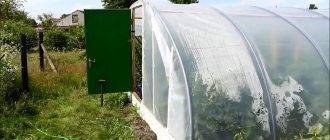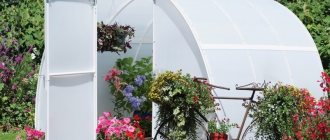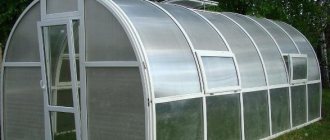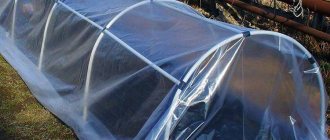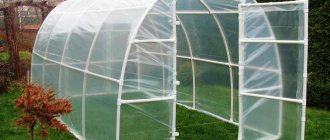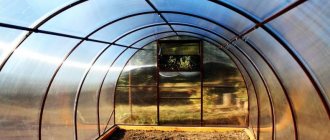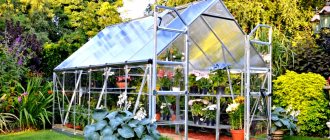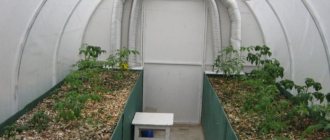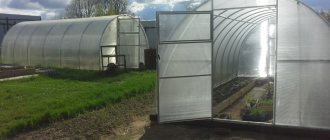Having your own plot of land often automatically means gardening and vegetable gardening. What could be better than vegetables grown yourself, despite the fact that caring for a garden is a troublesome task. But it is possible to make some processes easier and automate. If you create automatic watering in a greenhouse with your own hands, you will have more time for other things. Of course, organizing such a system is not an easy task. But if you try once, you can enjoy the work done for several years.
Pros and cons of the system
Reviews from gardeners who have already installed such equipment note a number of positive aspects:
- Significant reduction in time for planting care
- The quantity and quality of fruits increases
- Saving water and fertilizers
- Directional moisture supply
- Reducing the number of weeds
- Systems equipped with sensors accurately maintain temperature and water balance
The study of negative reviews boils down to the following shortcomings:
- Installation of the installation may require considerable labor or money
- There are a large number of cheap but unreliable watering kits on the market.
How to find a truly high-quality system in a store?
In Russia and neighboring countries there are many offers on the market. But most of them do not inspire confidence among ordinary summer residents, and in practice it often turns out that domestic models are only good for shop windows. And after purchasing them, you will have to modify, trim, and optimize a lot of things, until one day you come to the conclusion that it was easier to do all this with your own hands in the first place.
It is not without reason that the famous “Aquadusya” in Belarus is so popular in Russian greenhouses - it is truly a ready-made box solution that no longer needs to be upgraded or purchased additional parts. But the system itself is clearly morally outdated by 10 years - similar drawings could be found in Soviet Do-It-Yourself magazines. So what’s bad about something that has been in use for several decades? Answer: the system itself. Here are the main complaints you can often hear from owners of the Aquadusi greenhouse:
- The pump is not intended for irrigation - it only starts the system.
- The hoses are clearly made from recycled materials, have weak walls and end up being short-lived.
- Programming the unit to the desired mode is quite troublesome.
- The pressure throughout the system is completely different: the watering at the beginning is much stronger than at the end of the hose.
But expensive foreign drip irrigation systems for greenhouses of our inhabitants are so far only pleasing. Especially in the United States, there are many ready-made solutions that do not require any reprogramming or modification.
And GreenLine 64T is considered the highest quality system so far. It is enough even for a spacious greenhouse (64 bushes). The unit has many programs; you can even set it so that there is a 10-minute break in watering - this will allow you to avoid flooding the soil.
The hoses are strong and have good meterage. But the system, naturally, costs a lot. As for the automatic watering timers themselves, the best reviews so far come from the domestic OGO-Rodnik, which measures soil moisture rather than minutes, which is much more rational.
Main components
Any automated system with a similar purpose has common design components. Regardless of the final choice, any installation kit will contain fundamentally important elements:
- Source of water supply - well, water supply, borehole, etc.
- Capacity – necessary for heating water to the optimal temperature. Watering with cold water directly from the source can cause plant death.
- Pumping station - serves to adjust the optimal pressure. Depending on the design, constant pressure may be required to achieve optimal and efficient irrigation.
- The filter is a mandatory element of the system. Regardless of the quality of the liquid at the point of intake, the lack of filtration will sooner or later lead to clogging of elements with a thin cross-section.
- Faucet or electric valves - the autonomy of the system implies the presence of shut-off devices that serve to control the operation.
- Sensors, controllers, timers - to achieve maximum effect and independent operation of equipment, the use of electronic devices is necessary.
- Supply lines – deliver nutrient liquid directly to the watering site.
Design elements
Today, ready-made drip irrigation systems can be purchased in stores. They are selected according to the total length of the distribution branches, the type of drip lines, the distance between them and other parameters, which will be discussed in detail below. But many gardeners are interested in how to arrange drip irrigation in a greenhouse with their own hands, and whether it is possible to use improvised materials available on the farm.
Could be so. But in order to make a decision, it is better to first study the design in detail.
Sources of water and equipment for its supply
Water can be supplied to a drip irrigation system from a centralized water supply system, a natural reservoir, a well or a borehole. But the most common option is a large container installed on an elevated surface. The water in it is first settled and warmed, and then fed into the pipes by gravity.
Serving from a barrel is the most convenient solution Source yandex.ru
In all cases, except for watering directly from a centralized water supply system, it is necessary to install a pump that pumps water into the pipes at a given pressure. Or feeding it into a distribution container. The type and parameters of the pump depend on the type and depth of the source.
Since any water, even purified tap water, contains impurities in the form of fine sand, silt, particles of rust and undissolved salts, before watering the greenhouse, you need to take care of installing a filter. Without it, the system will quickly become clogged with debris and require cleaning. The main elements – the droppers – are especially affected.
The mesh filter is the most popular, inexpensive and easy to use Source yandex.ru
Pipelines
To distribute water throughout the entire bed or greenhouse, you need a main supply line and branches extending from it along each row of plants. The main pipeline is connected to a water source and equipped with a shut-off device. Most often this is a ball valve, but in an automated system connected to a pressure line or well pump, a solenoid valve is used.
The main line is made of plastic or metal pipes; watering hoses are less commonly used:
- Metal pipes are strong and durable, but their use in a drip irrigation system is not recommended due to their lack of resistance to corrosion. Rust microparticles quickly clog the drip holes.
- Watering hoses are subject to mechanical damage and are not durable.
- It is best to choose the option of making irrigation in a greenhouse with your own hands from PVC or HDPE pipes. These materials are distinguished by their reasonable price and sufficient mechanical strength, they do not corrode, and deposits do not form on their smooth internal walls.
Main line made of polypropylene pipe Source decorateme.com
See also: Catalog of country house projects
In ready-made systems, the role of distribution pipelines is played by drip tubes or drip tapes - flat thin-walled hoses with built-in drips. They come in two main types: emitter and slot:
- The emitter tape has a labyrinth inside with flat droppers located at a certain distance from each other. It can be compensated, which always ensures a constant flow of water from each drip, and uncompensated - its water flow through the drippers differs depending on the distance from the main line and the slope of the area. This type of tape is not cheap, but it does not clog easily and can be used for several seasons.
- The internal labyrinth of the slotted tape is equipped with droppers in the form of long slotted holes. They get clogged easily, so before you water the greenhouse with your own hands using this type of tape, you need to take care of a high-quality filter. But it costs much less than the emitter one, which, however, is offset by the short service life of 1 season in the open ground or a maximum of 2 seasons in a greenhouse.
Fragment of an emitter tape Source isanshop.ru
Drip tapes also differ from each other in such parameters as the total length, the distance between the droppers and their consumption characteristics, and wall thickness.
Note! Most belts are rated at around 1 bar. Therefore, they are used in gravity systems or a pressure reducer is used when connecting to a pressure water supply.
Drip tubes made of low-density polyethylene have thicker walls, so they can withstand high pressure and can work in pressure systems. They are also convenient because they are often produced without holes - they are made independently at the optimal distance for each crop. And external droppers are inserted into the holes or connected to the pipe using thin short hoses.
Drip tube with outlet for 4 droppers Source ekotec.com.ua
In ready-made kits you can find everything to assemble the system, including tubes of different diameters, droppers, adapters, bends for different numbers of outlets, and even pegs for fixing the tubes at the desired level. But all these elements can be purchased separately or replaced. For example, a very relevant question is how to make drip irrigation with your own hands in a greenhouse from a PVC pipe, since it is cheaper than its polyethylene counterparts, as are fittings for assembly.
Special droppers can be replaced with medical ones. They are good because each has a flow-regulating device in the form of a wheel that pinches the supply tube. But the tubes of medical droppers are transparent, which leads to rapid blooming of the water in them and, as a result, their clogging and the need for rinsing.
Homemade system of PVC pipes and medical droppers Source ro.aviarydecor.com
If you choose between drip tapes and tubes, then each type has its own advantages and disadvantages. The pipe system is more durable, it allows you to regulate the water flow and supply it individually to each plant. What is important when growing cucumbers, tomatoes, peppers and other “piece” crops. But it is more expensive than tape and more difficult to assemble.
Tapes are convenient to use when growing root crops, herbs, and strawberries. They are relatively inexpensive, easy to install and clean.
Automation
If the owners do not have the opportunity to constantly be on the site and monitor the condition of the plants, you can think about how to make automatic watering in the greenhouse with your own hands. This can be easily done by equipping the system with a timer. Depending on the functionality, such devices can not only turn on and off the water supply at a given time, but also individually control several lines, monitor the pressure in the network and the operation of pumping equipment, and serve as a water consumption meter.
Types of automatic watering
Many plants require special care, so water delivery to the beds is organized in various ways.
- Subsoil watering method
- Drip irrigation
- Rain water supply
- Aerosol spray
Different methods differ not only in the method of watering, but also in the requirements for materials and installation.
Why is it needed and where is it used?
Not all owners of summer cottages have the opportunity to be there permanently. And if in your absence at least watering is automated, what does this give?
Here are some reasons for the usefulness of such systems:
- Saves time.
- Productivity increases.
- Timely and economical watering for systems with a sensor.
- You can direct water directly to the roots of plants.
- Significant weed reduction.
But there are some inconveniences:
- Installing and configuring the entire system will take time and require financial investment.
- Cheap kits can break down quickly.
As you can see, there are more advantages. In addition, if you try and set up the work efficiently, the system will serve well for a long time.
Subsoil
Pipes with holes for water supply are laid underground so that moisture flows directly to the roots of plants.
Well suited for capricious greenhouse crops. Promotes additional saturation of the soil with oxygen. Maintains constant humidity in the greenhouse atmosphere. Saves water.
Failure to comply with installation instructions may result in over-moistening or drying out of the soil. The process will require serious labor during installation.
How to make automatic watering at no cost?
Making a hole in an old rubber hose in order to ensure proper drip irrigation in a greenhouse or greenhouse is not enough. After all, it is necessary, first of all, to create a certain pressure inside the irrigation system so that uniform watering occurs throughout the entire hose (especially on an uneven surface). Therefore, you can build irrigation using ordinary PVC pipes, as in this project:
Or follow these instructions:
- Step 1. Above the bed that needs to be watered, you need to build a horizontal support, at a height of 1.2 meters above the ground.
- Step 2. You should now attach several 1.5 liter plastic bottles to the prepared support, with a hole drilled in the bottom of each of them.
- Step 3. You need to insert a plastic needle with a regular medical dropper into these holes.
- Step 4. Now you can pour water into the bottles, but the flow must be adjusted so that all drops flow out evenly from the other end of the medical dropper.
Drip
Through perforated pipes, water is delivered directly to each plant.
This principle of organizing the irrigation system ensures water savings of up to 30%. There are no favorable conditions for weeds. Loosening the soil needs to be done much less frequently.
High demands on cleanliness. Lack of filters can lead to rapid clogging.
Pipe selection criteria
There are two main categories into which polypropylene pipes are divided - reinforced and unreinforced. The latter differ from the former by the presence of an additional layer of aluminum or fiberglass.
There is a common misconception that reinforced pipes are more durable than conventional pipes. It is true only for hot water supply systems.
Purchasing products with special layers when using cold water is a waste of money , which is why ordinary pipes are used in irrigation systems.
Material
Polypropylene comes in several varieties. It is worth considering products labeled PP-1 or PPH, as they are designed to work with cold water.
PPR pipes made from the latest types of plastic are also suitable. They are versatile and durable, resistant not only to internal heat, but also to external heat - ideal for greenhouses. If the irrigation area is small, you can give preference to a simpler option.
Some pipes have an additional outer coating to protect against ultraviolet rays . If your budget allows, then it’s worth taking them. The higher the price of such products, the better the quality of the protective layer.
Pressure
Maximum operating pressure is important. It varies in the range of 10-25 atmospheres. If you select components with too low a characteristic, the frequency and force of water hammer will be extremely high, which will lead to constant breakthroughs. But there is no need to overpay for too high indicators. Pipes with a pressure limit of 16 atm are suitable.
Diameter
Also, when choosing, you should pay attention to the diameter . This characteristic is closely related to the previous one.
Here it is very important not to make a mistake in choosing. If the diameter is too small, the speed of water flow through the pipes will be reduced and efficiency will suffer.
Calculations should be made based on the physical properties and volume of water entering the system . Water moves through pipes due to pressure.
If it is low, and there are no additional devices, such as a circulation pump, then it is worth taking pipes of a larger diameter. This should also be done if liquid is supplied in large quantities. At high pressure and low water volume, a hole diameter of 25-27 mm will be sufficient.
Rain
Through sprinklers, water falls onto the soil in the form of raindrops. The nozzles can be installed at ground level or mounted under the ceiling of the greenhouse.
The main advantage is the large coverage area and the creation of an optimal microclimate. The penetration of moisture to the optimal depth activates the vital activity of microorganisms.
Incorrect settings will contribute to over-humidification of the air in the greenhouse. During periods of high solar activity, burns of delicate greenhouse crops are possible.
Additional lighting and heating
Some plants may not have enough daylight to grow, so supplemental lighting systems may be needed. The cable for such systems can be located either underground or suspended. The main thing is that all wires and their connections are insulated. You should also use lamps that do not get hot, otherwise they can affect the overall temperature inside the greenhouse. Plus, the lighting fixtures used must be moisture resistant.
https://www.parnikiteplicy.ru/youtu.be/P4CnNsRrFPA
If the greenhouse will be used to grow vegetables, fruits or flowers even in winter, then a heating system will be needed. There are quite a few ways to heat a greenhouse: using solar batteries, using gas, using a solid fuel boiler, etc. Conventional stove heating is considered the most profitable at the moment; the stove itself is built in the vestibule of the greenhouse, and the chimney runs through the entire greenhouse or even under the beds.
Thus, the gardener now has at his service not only his own hands and agricultural implements, but also various automation systems designed to make life easier and significantly increase the productivity of greenhouse plants. Progress does not stand still, and soon even fully automatic greenhouses may appear on our garden plots.
Aerosol
An improved type of rain irrigation. The system uses high fluid pressure and deluge nozzles. The holes in them have a much smaller cross-section than those of rain nozzles, due to this the spraying effect is achieved.
If it is necessary to maintain a certain level of temperature or humidity, such an automatic watering system will be most effective. Well suited for growing seedlings or cuttings. The development of the root system occurs as quickly as possible.
The need to maintain high pressure in the supply lines, control temperature and humidity is provided for by this automatic watering in a greenhouse with automation.
Equipment for automatic systems
Automatic watering for a greenhouse is a costly undertaking at first. Therefore, almost every land owner tries to choose inexpensive but reliable equipment that can ensure stable operation of the system.
The main attention should be paid to the choice of automatic control systems, which use timers or controllers. Timers are simpler devices; they can be used to set the start and end times of watering during the day. You can set up several sessions during the day.
Equipment for automatic irrigation control Source allegroimg.com
Controllers can be single-channel or multi-channel. The former are used in small greenhouses, while the latter are capable of simultaneously serving several greenhouses or providing several irrigation modes. The controllers differ in that they have a display on which irrigation time, water consumption and other indicators are set
The most expensive models are equipped with GSM modules, which provide the ability to control the system remotely from a phone.
The second most important equipment is the pump. If the water is supplied from the water supply system, then you can do without it. But usually automatic systems provide an intermediate tank in which the water is heated to a temperature comfortable for the plants. In this case, a pump is needed to fill the tank. When choosing it, take into account:
- power (volume of water passed per unit of time);
- dimensions and weight that you need to know for fastening;
- type (submersible, surface);
- power supply method (electric, diesel);
- efficiency (consumption of electricity or other fuel required to fill containers).
The optimal model should cope with the given volumes of work and have a small additional power reserve.
Water filters Source allegroimg.com
Another mandatory addition is filters that are mounted between the container and the watering hoses. Their main task is to retain solid particles found in liquids so that they do not enter the system and clog the system. Typically, mesh filters are used that can be easily removed, cleaned and returned to their place.
When installing an irrigation system in a greenhouse, care must be taken to ventilate the room to ensure natural evaporation.
Tips for operation and installation
The simplest automatic watering for a greenhouse can be done with your own hands. To set up homemade automatic irrigation, you need a minimum of effort and money. It is enough to make a hole in the place where you need to deliver moisture, cut off the bottom of an ordinary plastic bottle, make holes in the cork, place it in the hole and fill it with water.
Such a system can only be called automatic only conditionally. Human intervention is still necessary, but this is no longer daily manual watering; containers will need to be filled once every two or three days. You can improve the design and run a water hose with branches to each bottle.
In this way, the automatic watering for the greenhouse will be replenished - from the barrel. It will be enough to open the tap. The simplicity of the design does not deprive it of its disadvantages. Over time, plant particles, soil and debris that get into the bottle can clog the holes.
To make this happen as rarely as possible, you can put gauze or any other suitable material in the cork, and you can close the hole at the top. The described primitive design can be modified by any available means. Depending on desire and need.
Installing more advanced systems will require investment and certain installation skills. A controller, sensors and auto-watering timer for greenhouses will allow for more precise settings and quality plant care. If desired, such a system can be made completely autonomous.
Examples of various systems can be seen in the photo of automatic watering for a greenhouse. The costs of installing such a structure will be more than recouped by invaluable free time and fresh, tasty fruits from your own greenhouse.
Do-it-yourself drip irrigation: video
You can replace them with existing hoses and tubes at home, but here you will have to decide how important the practicality and long-term operation of the created system is to you.
Choosing a location for installation
If everything is more or less clear with the placement of tapes and main tubular lines (they should be located in close proximity to the beds), then where to locate the volumetric water tank is not always clear.
If a pump is provided in the design of the system, then the barrel does not have to be placed on a hill and you can leave it next to the greenhouse, having previously placed a fixing podium made of boards under the bottom.
Did you know? The historical predecessor of modern greenhouses were Roman carts with soil, which gardeners pumped out into the sun every day and returned to the heated room when it set. Such actions helped provide the Roman Emperor Tiberius with fresh vegetables all year round, most often his favorite cucumbers.
To organize automatic irrigation without a pump, you will have to install the tank on an elevation, which in some cases should be at a height of 2 m from the ground surface. For long service life of the equipment, it should be hidden from precipitation by installing a small canopy over the barrel.
Simply put, the specific installation location is selected based on the personal preferences of the gardener and schematic calculations of the automatic watering system, so there are no other important requirements here.
Photo of organizing automatic watering in a greenhouse
Commissioning
Before starting operation, the drip system must be checked for malfunctions . A superficial inspection will reveal only obvious errors.
Detection of poor-quality welding and loose connections is carried out by supplying water to the system under low pressure. If no violations are detected, then the pressure gradually increases and the process is repeated.
Tape
Drip tape is made from thin materials, so it cannot be subjected to heavy loads.
The pressure should be such that water flows out of the part, but does not put pressure on its walls. Also, the holes of the tape must be regularly checked and cleaned of dirt.
With droppers
As in the previous case, strong pressure should not be applied to the droppers . They will fly out of the soil and can cause damage to plants. The amount of water should be small, as it is delivered closer to the root.
Setting up automation
Once all detected problems have been resolved and the final check is satisfactory, you can proceed to configuration.
There is nothing to configure on manual control systems, while automatic ones require some calibration. It is carried out using a controller equipped with an electronic display and buttons.
There you need to set the duration and regularity of watering . The first is influenced by the required amount of water calculated earlier.
The higher it is, the longer watering should continue. Regularity depends on the temperature and weather conditions of the region. The hotter and drier the area, the more often irrigation should be carried out.
Moisture and temperature sensors will help you get rid of unnecessary calculations . Together they create a precise and adaptive automatic drip irrigation system.
Irrigation system design
The first step is to construct a planting scheme with the exact location and number of plants. Typically, the greenhouse area is divided into three zones:
- for large plants, the step length between bushes is 40-45 cm;
- for medium plants – step 30 cm;
- for greens – 10-15 cm.
Dispensers are positioned according to the step length. The diagram then marks the passage of the drip irrigation system. Ideally, you should try to minimize the length of the pipes, the number of turns and connections.
